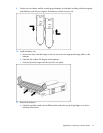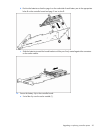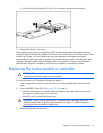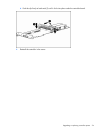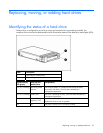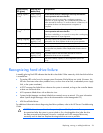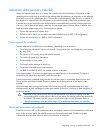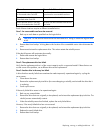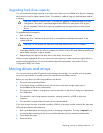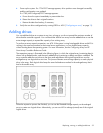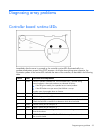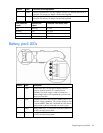Replacing, moving, or adding hard drives 27
Effects of a hard drive failure
When a hard drive fails, all logical drives that are in the same array are affected. Each logical drive in
an array might be using a different fault-tolerance method, so each logical drive can be affected
differently.
• RAID 0 configurations cannot tolerate drive failure. If any physical drive in the array fails, all non-
fault-tolerant (RAID 0) logical drives in the same array will also fail.
• RAID 1+0 configurations can tolerate multiple drive failures as long as no failed drives are mirrored
to one another.
• RAID 5 configurations can tolerate one drive failure.
• RAID 6 (ADG) configurations can tolerate the simultaneous failure of two drives.
Compromised fault tolerance
If more hard drives fail than the fault-tolerance method allows, fault tolerance is compromised, and the
logical drive fails. In this case, all requests from the operating system are rejected with unrecoverable
errors. You are likely to lose data, although it can sometimes be recovered (refer to "Recovering from
compromised fault tolerance" on page 27).
One example of a situation in which compromised fault tolerance may occur is when a drive in an array
fails while another drive in the array is being rebuilt. If the array has no online spare, any logical drives
in this array that are configured with RAID 5 fault tolerance will fail.
Compromised fault tolerance can also be caused by non-drive problems, such as a faulty cable or
temporary power loss to a storage system. In such cases, you do not need to replace the physical drives.
However, you may still have lost data, especially if the system was busy at the time that the problem
occurred.
Recovering from compromised fault tolerance
If fault tolerance is compromised, inserting replacement drives does not improve the condition of the
logical volume. Instead, if the screen displays unrecoverable error messages, perform the following
procedure to recover data:
1. Power down the entire system, and then power it back up. In some cases, a marginal drive will work
again for long enough to enable you to make copies of important files.
If a 1779 POST message is displayed, press the F2 key to re-enable the logical volumes. Remember
that data loss has probably occurred and any data on the logical volume is suspect.
2. Make copies of important data, if possible.
3. Replace any failed drives.
4. After you have replaced the failed drives, fault tolerance may again be compromised. If so, cycle the
power again. If the 1779 POST message is displayed:
a. Press the F2 key to re-enable the logical drives.
b. Recreate the partitions.
c. Restore all data from backup.
To minimize the risk of data loss that is caused by compromised fault tolerance, make frequent backups of
all logical volumes.



